| Much Adu about Apple Pie, Pilgrimage to Jomosom Day
3: Trek back to Jomosom (4.5 hrs) and on to Marpha (2 hrs)
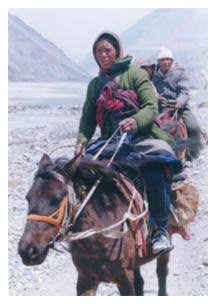 We
left early in the morning and were soon joined by the crowd coming from
Muktinath. We headed down the same single trail but just before the
descent to Kagbeni, we veered off to the left and headed back for
Jomosom. After some time, we descended into the Kali Gandaki gorge and
followed the riverbed back to Jomosom. Here, though, the river was but a
series of thin shallow streams in the dry time before the coming
monsoon. We were passed numerous times by Nepalis descended from
migrating Tibetans that lived throughout the region. They travelled to
Jomosom to trade and buy goods unavailable anywhere else in Mustang. We
left early in the morning and were soon joined by the crowd coming from
Muktinath. We headed down the same single trail but just before the
descent to Kagbeni, we veered off to the left and headed back for
Jomosom. After some time, we descended into the Kali Gandaki gorge and
followed the riverbed back to Jomosom. Here, though, the river was but a
series of thin shallow streams in the dry time before the coming
monsoon. We were passed numerous times by Nepalis descended from
migrating Tibetans that lived throughout the region. They travelled to
Jomosom to trade and buy goods unavailable anywhere else in Mustang.
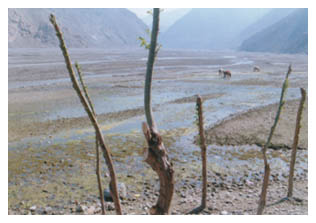
The Kali Gandaki
Riverbed north of Jomosom
Walking faster than Ken and Lisa, we
searched high and low for the famous saligrams, fossils of marine
animals found inside smooth black stones. They are believed to be
representations of Vishnu but also evidence that the Himalayas were once
under water. They are supposedly plentiful along the riverbed north of
Jomosom. We'd pick up a stone that looked promising and find another
much larger one to pound it against until it cracked, looking for any
tell-tale signs of fossils, but we never found any. As they are on sale
(illegally) all along the trek, the area was sure to have been swept
clean.

About an hour before Jomosom, we
stopped at small home to rest. I appreciated his idea of a lawn ornament
as we were welcomed in by the head of a yak. The owner was an amiable
fellow and we chatted awhile and drank plentifully from the small stream
he had diverted into his kitchen, while Ken and Lisa sipped their iodine
water from Nalgene bottles. An aside, don't do as I do. Having spent a
good amount of time in Nepal, my system was adjusted to the
peculiarities of local water, but that fresh, crystal clear stream
trickling out of the Annapurnas will probably wreck havoc on yours.
In Jomosom, we stopped to visit a
friend, Vim from Devi's village, who was a teacher in the boarding
school there. I took some time to talk with the students. It was a
holiday and they were all in the hostel, chattering away. The school was
one of the few English boarding schools for the entire district and it
mainly drew students from villages throughout Upper Mustang including a
large contingent from Lo Manthang. Still feeling good, we decided to
continue on to Marpha and after checking in at the ACAP post, crossed
the Kali Gandaki which had become a full-fledged river by this point.
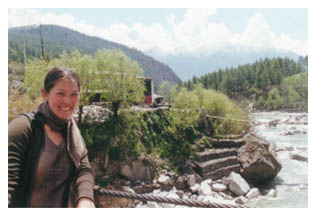
The trail between Jomosom
and Marpha was flat, exposed and very windy, poised as it was to receive
the full brunt of nature. The trail here was wide and easy going. For a
number of years, officials have been kicking around an idea of building a
road to Jomosom and it was evident that portions had already been cleared.
Marpha appeared around a small hill, and the white-washed walls were the
first thing that struck me as we passed under a gate to enter. The second
thing was the absolute bad luck of a traveller who asked us if we had seen
his passport anywhere along the trail from Jomosom. He hadn't replaced it
in his waist pouch after he presented it at the ACAP checkpoint, but
instead thrust it carelessly into his jacket pocket. Convinced it hadn't
been stolen, but merely dropped accidently, he headed out dejectedly to
retrace his steps back to Jomosom.
 In contrast to the other
villages we had visited, Marpha virtually gleamed. It was fresh and clean,
and surrounded by the apple orchards that made it famous. Here, my
piligrimage to taste the apple pie that beckoned travellers from all
around was finally to be fulfilled. We pulled in and settled at the
Paradise Lodge and immediately set out to explore. In contrast to the other
villages we had visited, Marpha virtually gleamed. It was fresh and clean,
and surrounded by the apple orchards that made it famous. Here, my
piligrimage to taste the apple pie that beckoned travellers from all
around was finally to be fulfilled. We pulled in and settled at the
Paradise Lodge and immediately set out to explore.
We made our way to the
main monestary that stood out above Marpha and climbed the long stairway
to the top. It gave us a great birds-eye view of the town, and also the
distinct feeling that we were rats running around in maze. The
architecture was distinctly Mustang, with the load of wood piled up neatly
around the perimeter of every building, the safeguard against long
winters.
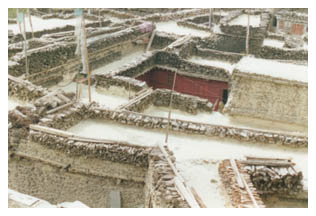
the rooftops of
Marpha
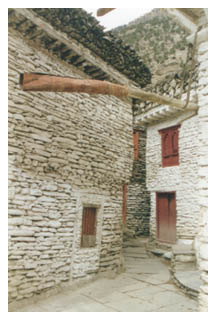
Descending back into the
maze of streets, I was fascinated by the beauty of such mundane details
like a water spout that jutted far into the street, precariously
cantilevered as it was. The carved wooden windows,
painted in the same dusty red, set into bright whitewashed stone
exteriors.

The cobble-stoned
alleys that invited you in to explore and then taunted you with dead-ends.
Back at the Paradise
Lodge, we settled into the cozy common room and dispensing with any
formalities, quickly began a mean game of marriage.
Now, all throughout
Nepal, if you are discerning enough, you will notice small clusters of men
gathered around playing cards, but not just any game. Marriage is the de
facto national past-time, and generally the sole dominion of men, as it is
a wager heavy game. The money transactions at the end of every round,
might seriously challenge the options pit at any stock market. It starts
with three decks, up to 6 players and 21 cards dealt to each person. That
in itself is an art form, managing and holding a neatly fanned out set of
21 cards. Then a joker is chosen randomly and the game begins. The idea of
the game is standard rummy, but the betting is distinctly Nepali. They
have managed to assign bets to a variety of cards and card combination to
boggle the mind, and get this! The money that a card represents is paid to
each and every player simaltaneously. What this means is that when you
have a few money cards of your own, all varying amounts, you will collect
that money from each and every player, but remember that every other
player may also have some money cards and be collecting from everyone
else, INCLUDING you. The math is stunning. While I can easily compute it
for two players, and even three, I was, and still am, completely in the
dark as to how they do it for 6 players. And there is no holdovers, all
bets are played and nothing is owed from hand to hand, or total chaos may
reign.
Later in the evening, we
met again with a lovely family from Australia that we had first
encountered on the trek up to Muktinath. There was the mother, father and
three lovely girls along with their guide. We spent the rest of evening
playing cards with them. Why mght I mention such an introduction at this
junction? They have yet a part to play in my tale.
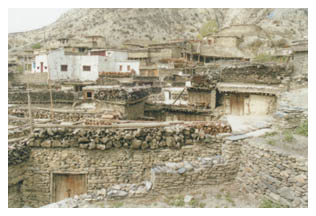
And, I finally had my
apple pie. A light, fluffy crumb crust topping a delicately spiced
interior, rich with fresh, still slightly crisp apples and the tell-tale
smattering of brown cinnamon specks. mmmmmm
But to tell the truth,
any crude rendition, heavily doused with sugar and overloaded with apples
might have sparked the same reaction in a trekker, starved for the flavors
of home, weakened by the day's exertions, and overcome with the need to
ingest a safe, unspiced food that won't seemingly prompt stomach-ripping
cramps and nightly excursions to the bathroom. As I am reflecting back on
that foodie moment, I wonder if that's not what was mixed into Marpha's
famed apple pie.
next
| Day 3 |
back
|
